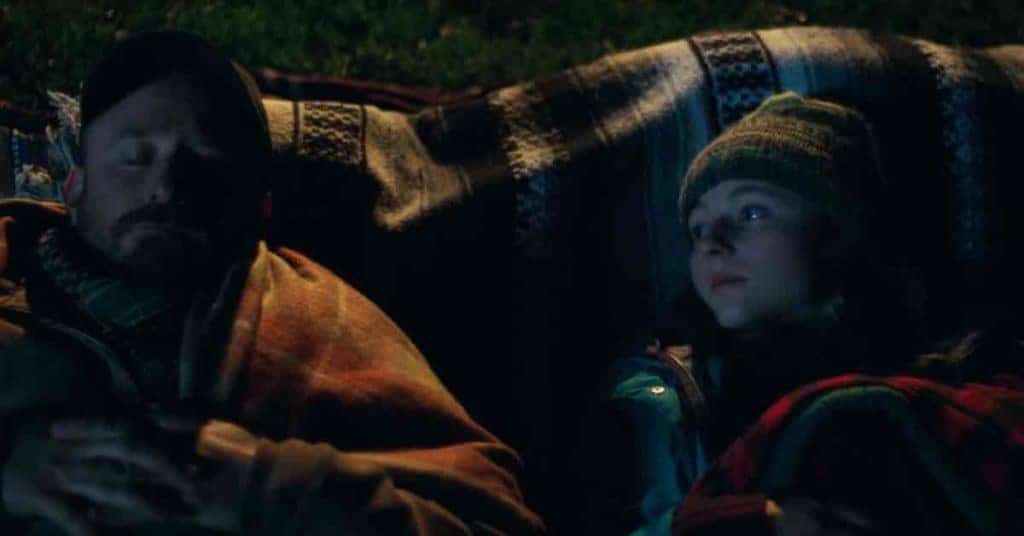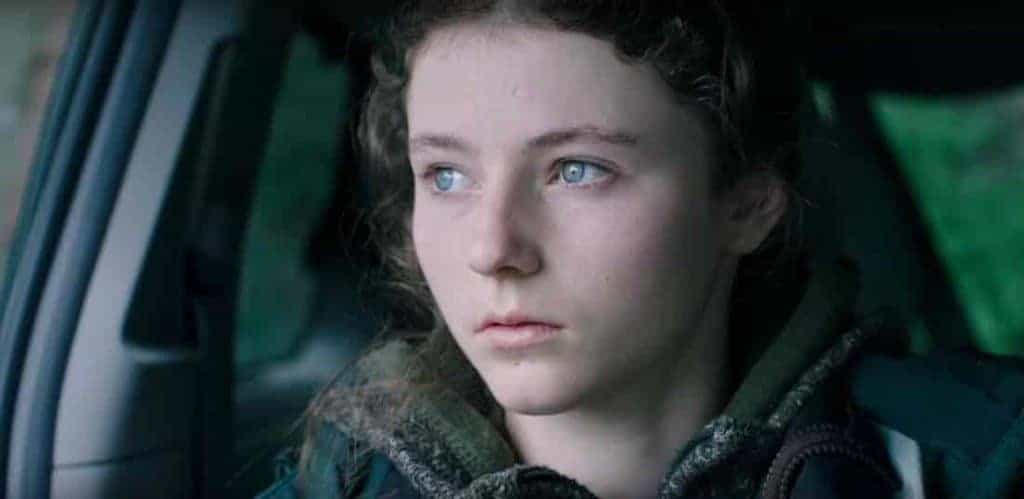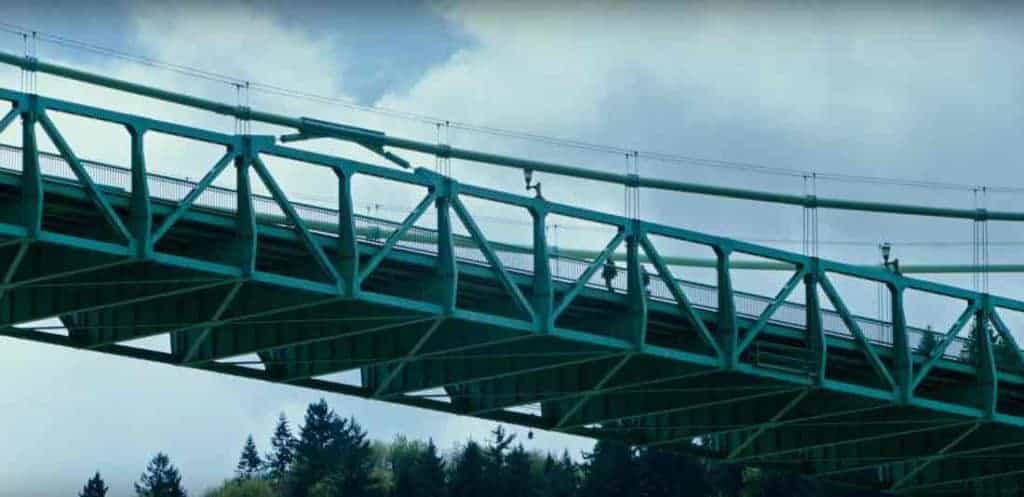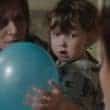Editor Jane Rizzo discusses cutting Leave No Trace, developing the father-daughter relationship, building the soundscapes for different locations, and restructuring the story in the edit. This is the sixth article in our Special Issue on Debra Granik’s Leave No Trace , which is now available as an ebook.

“Every time you make a cut, subconsciously, the audience is adjusting to a new shot,” Leave No Trace editor Jane Rizzo told me, which could serve as a sort of manifesto for her approach to editing. “Any time you are making a cut, there should be a reason. Do you need two shots to tell the moment, or can you just tell that moment in one shot? Less shots is more.”
This less-is-more approach has informed Rizzo’s decision to regularly swap between editing for TV (High Maintenance, Red Oaks, and most recently Succession) and editing for film (Compliance, Ain’t Them Bodies Saints, Gabriel). She views working in TV as a great opportunity for brain training as an editor — learning to put scenes together quickly to fit in with an existing aesthetic. Films are a bigger emotional and time investment, and they’re where she feels she really gets to stretch herself creatively.
[click_to_tweet tweet=”Editor Jane Rizzo: ‘Every time you make a cut, subconsciously, the audience is adjusting to a new shot.'” quote=”‘Every time you make a cut, subconsciously, the audience is adjusting to a new shot.'”]
How Jane Rizzo creates the first assembly
When preparing to work on Leave No Trace, Jane Rizzo “met with [Leave No Trace director] Debra Granik a couple times before they started shooting, and we just talked about movies that we liked. As an editor, you know you are going to be sitting in the room with the director for a long time, so you want to make sure you have similar sensibilities about films and books and music.” Rizzo got her start in documentaries and was keen to collaborate with Granik who shared that sensibility. They were inspired by documentaries like Terra Firma and the docu-fiction films of Roberto Minervini. But Rizzo and Granik also took cues from coming-of-age stories like Alice Rohrwacher’s The Wonders — which Rizzo described as almost “feeling like a doc” — and Céline Sciamma’s Girlhood.
Rizzo was intimately involved in shaping the film from day one, including helping to determine what got shot. Though she wasn’t on location, she communicated regularly with Granik as the dailies (footage from the day’s shooting) came in — not just about what the footage looked like, but about what was missing. “I like to start assembling scenes as soon as the footage is coming in. It’s for the directors to know that they are getting good stuff or whether they need additional scenes of lines or pickups or transitions.” For example, Rizzo requested B-roll during the Forest Park shoot so that there would be plenty of interstitial shots of leaves rustling or spiderwebs to use as transitions.
[wcm_nonmember]
Want to read the rest of the article?
Get the Leave No Trace ebook
Relive the highs and lows of Debra Granik’s remarkable coming-of-age story and discover how the filmmakers brought it to life.
[/wcm_nonmember]
[wcm_restrict]
Rizzo views sound as key to storytelling, so she started building the film’s soundscape as soon as she started editing. She even asked for additional production sound during the shoot. “I try as much as possible to use the sounds from that location, and then I have a little sound library I will use for refrigerator hum in the kitchen, night crickets. That kind of stuff. A lot of the sounds in Forest Park are from Forest Park. A lot of the sounds of the trees being chopped are actually from this footage of Debra scouting tree farms. It’s great if the production sound mixer, when they wrap the location, shoots a bunch of tone. It’s hard for them to do, sometimes, because you need to get a crew of 60, 80 people to all stand still for a minute or two,” Rizzo acknowledged with a laugh. “They don’t like to do that, but it’s so much better when you can use the real sound.”
During the shoot, Rizzo started putting together the initial assembly on her own. Without the director there, she had to read between the lines of the footage to understand what the director was aiming for. “I’ll get a sense of how Debra will want a scene to be built. If she’s reshooting stuff over and over I can kind of get a sense that she definitely likes that beat and wants that beat in.” The lines of communication between Rizzo and Granik were always open.
Read the rest of the Leave No Trace Special Issue >>
Choosing the right moments
“The beauty of the film was, there were so many great moments. It’s a good problem to have, that you have too many moments to pick through as opposed to trying to find something and not having anything. The challenge of the film was that there were so many of those moments we had to cut down.”
[click_to_tweet tweet=”‘It’s a good problem to have, that you have too many moments to pick through as opposed to trying to find something and not having anything.’ – Jane Rizzo” quote=”‘It’s a good problem to have, that you have too many moments to pick through as opposed to trying to find something and not having anything.’ – Jane Rizzo”]
Jane Rizzo partly attributes this to Director of Photography (DP) Michael McDonough’s spontaneous and cinematic shooting style. Some of the film’s best moments were unplanned: “There’s the scene when they go to visit the VA. They were incredibly lucky the helicopter came by. The DP was just able to turn the camera on and shoot. That’s a great shot of [Will] just looking [at the helicopter] and [Tom] looking at him. That was just luck that we were able to use.” McDonough captured even seemingly insignificant actions in a way that felt cinematic: “even when Ben puts his hands over the fire, it’s just a beautiful moment. We would have so many within a sequence that at some point, you’re just like, ‘Well, we can only have one shot of Ben’s hands over the fire, so let’s just pick one.’”

Because the actors were always in character, every moment they were on screen gave insight into the characters. The challenge was paring down all that good footage to essentials. Rizzo gave the example of the scene where Tom is being taken to the social services centre. “When they’re separated, and Tom is taken in the car, we had moment after moment after moment that were just beautiful. Her face is so luminous, and the way she walks really sadly down this path… You take a step back, and the most effective way to tell this moment is just the close-up of her in the car with the door shutting — the sound of the van door slamming. If you start having too much of those moments, it diminishes the power. When do we play the really beautiful, sad shot of Tom: at the beginning as she’s walking away from the park, or in the middle of the path, or when she’s at the car?”
Granik often shot traditional coverage to give Rizzo the flexibility to home in on the precise moment and framing to best communicate each story beat efficiently. When Tom and Will are reunited after several days of separation at the social services centre, they come together from opposite ends of the room. “They have this big, beautiful embrace. Can you tell that in three shots, or is it more efficient, and more moving, if you just have it in one shot, and you hold it longer? We had a lot of coverage there. We had the wide shot. We had her close-up. We had his close-up. We had an entire two-shot. But actually, you get the intensity of their embrace from the distance, and we held that shot for quite a while.”
Rizzo’s approach is to “cut quite fat. I want to have as much as possible in the assembly.” Then she can start to pare it down with the director after the shoot. “The first cut of the film was about four hours long. We didn’t get them out of the park until almost an hour in because there was so much beautiful footage. They find mushrooms, and then she finds mushrooms elsewhere, and then she reads her book about mushrooms, and we had a whole anatomy lesson about finding a dead animal in the woods. There were a lot of scenes that we had to cut because we needed to get them out of the woods faster.”
Designing the soundscape

Debra Granik and Jane Rizzo meticulously built the film’s soundscape to create a strong sense of place. “We wanted the locations to sound very different. In the forest, the sound is very full. As you get closer to the road, I think you are more aware of the outside world. Once you are in the town, all the traffic sounds are drowning and really loud. Even in the farm, we always had trees being chopped in the background; it’s very subtle, but it’s there. Debra was very precise. She was like, ‘I just want to hear a bunch of trees in the farm section as a constant reminder of what the Will character has to do now. They’re surrounded by it.’”
[click_to_tweet tweet=”‘We wanted the locations to sound very different. In the forest, the sound is very full. As you get closer to the road, I think you are more aware of the outside world.'” quote=”‘We wanted the locations to sound very different. In the forest, the sound is very full. As you get closer to the road, I think you are more aware of the outside world.'”]
Sometimes, sounds from the real locations would interfere with the story. “Forest Park just sounds awesome. There was a little stream right near where their camp was so we actually had to EQ a little bit of it out because you never see it. We were like, ‘is it going to be confusing if you hear a river, and you don’t see it?’ It’s there, because it’s in the production sound, but it’s muted. There’s so much more — birds and trees and winds — that I think slightly covers the fact there was a stream right next to their camp. The farm was actually near a tiny airport, so there were a lot of planes. We realized the plane could actually work as helicopter [sounds].” It ended up being serendipitous for developing Will because “helicopters were part of his past in some way — we don’t delve too much into it — but that’s definitely what wakes him in the nightmares.”
How Jane Rizzo restructured the story in the edit
In the editing room, Jane Rizzo and Debra Granik found themselves restructuring each section of the original script. The film was “shot in order as in the different locations,” but “a lot of the scenes within [each] section were reshuffled a lot.” In each section, you “need to be absorbed into that world, but how many details of that world do you need to have? [In the forest], we had a lot of them fixing tarps and trying to cook mushrooms with an umbrella solar panel. At some point, we had to move on. And the same for the other sections… There were a bunch of scenes that were cut.” Initially, Tom was meant to wait alone in the cabin for two days for her father to return, but “we felt, dramatically, she would be so scared after one night that she would just go the next day and look for her father. We had so much more even there. From the four hours, it went to three hours, and then to two and a half. At that point, it was short enough that we could get really trusted friends to come in and give us feedback.”
Most films hold three or four test screenings; Leave No Trace did eight on a big screen: once with 50 people, and the rest with about 10 close, trusted friends. This was, Rizzo says, “more test screenings than any other film I’ve worked on.” Granik and Rizzo leveraged feedback from these screenings to build toward Will’s and Tom’s separation. The film went through so many different versions, which made outsider perspectives particularly valuable — people who hadn’t read the script, hadn’t lived with the film, and didn’t know all the filmmakers.
Because Leave No Trace was always designed as Tom’s story, the challenge in the edit was ensuring we still understood and felt for Will. Granik and Rizzo relied on test audiences to tell them when Will was too opaque or too cool, and they recalibrated accordingly. They were constantly asking themselves, “‘Do we need to make Will softer?’ He’s a hard character, an introverted, interior character. It’s that fine line of not wanting him to be completely unrelatable. There was a lot of trying to make Will softer, going back to all the footage of Will and being like, ‘Where is there a smile, or a dignified look, that we can put in to soften him a little?’”
The film’s structure is so crucial for preparing us for Will’s and Tom’s impending separation. In Forest Park, “it feels very much 50/50, how much you get from both of them. As the movie progressed, we are more and more with Tom.” When we see them pulled apart at the social services centre, Rizzo cuts back and forth between each of their stories, only returning to Will when Tom asks questions about him; otherwise, we stay with her. At the Christmas Tree farm, we still cut from one scene with Will to one scene with Tom and back, but Tom’s scenes are longer. Their next separation is self-imposed, when Will leaves Tom in the cabin in the woods in Washington as he goes to search for food. This time, we stay with Tom throughout for the first time — the film separates us from Will before Tom decides to separate fully from Will. Finally, in the trailer park community, Rizzo and Granik actually cut Will out of the gathering scene where the crowd, including Tom, is listening to the musicians; Foster was initially in the scene, but they removed him to give Tom more space from Will.
“If you were to look at the finished film, and what was part of the first cut Debra and I did, it’s actually much closer to it than the 15 different iterations of the film in between. Initially, I think we were really good. Then, I think we started moving stuff too much around and maybe listening to too many voices. At the end, it ended up being quite close to what we started off. But I think it was part of the process that we needed to go through… Debra just liked to see a lot of different versions of scenes and a lot of different orders, scene structures. There’s very little story that happens, so it really is about building the moments and how many of those moments. What if we put these two moments in? How does it affect a moment 20 minutes later? If we have two Will smiles in the beginning, is it just going to be too much later on, or do we withhold Will smiling until 15 minutes into the movie? There were so many moving pieces within each section.”
Read the rest of the Leave No Trace Special Issue >>
Before Jane Rizzo, we’ve talked to several film editors in our Special Issues. Jonathan Alberts discussed his ongoing collaboration with director Andrew Haigh, which started with the TV series Looking and continued with 45 Years and Lean on Pete. Unlike Granik, Haigh prefers not to do any test screenings at all; he doesn’t want outside voices distracting him, so it’s Alberts’ job to provide a more distanced perspective. Joe Bini discussed editing Lynne Ramsay’s extremely precise You Were Never Really Here and Andrea Arnold’s more free-wheeling work, which had more of a documentary-like feel to it. Nick Fenton told us about editing On Chesil Beach and the importance of editing for performance. Documentary filmmakers have repeatedly told us about how crucial editing is to their process. We’ve compiled some of the best interviews with master documentarians in an eBook, Doc Masters: In Their Own Words Vol. 1, in which Frederick Wiseman, Gianfranco Rosi, Steve James, Penny Lane, and more discuss their differing approaches to editing.

